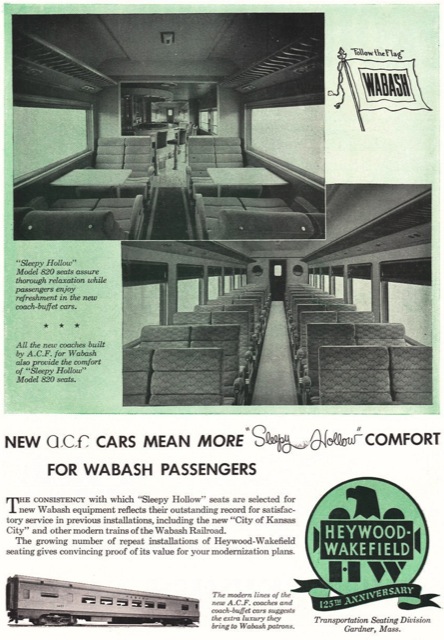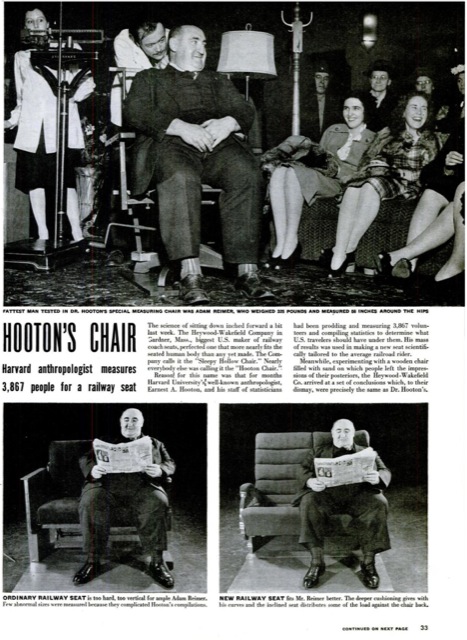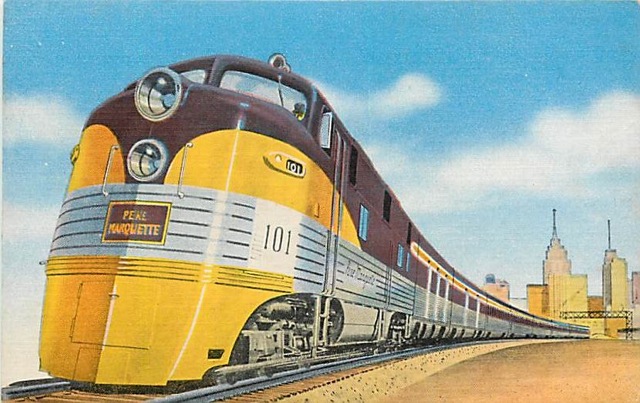The first railroad to introduce a new streamliner after the war was the Pere Marquette, a Michigan railroad affiliated with the Chesapeake & Ohio. Starting in 1946, the Pere Marquettes–the only streamliner I know named after the railroad that owned it–ran several times a day between Detroit and Grand Rapids.
The train was led by a General Motors E7 locomotive, the 2,000-HP successor to the 1,800-HP Santa Fe E1 and later E locomotives. The E7 noses were not slanted as much as some of their predecessors, and in fact were virtually identical to General Motors’ F locomotives, which were originally intended mainly for freight but which some railroads later used for passenger service.
The train itself initially carried only coaches and modest dining facilities. The cars were built by Pullman of Corten steel, but had a stainless steel appearance. Pullman achieved this without paying royalties to rival Budd for its shotwelding process by simply bolting fluted stainless steel panels to the outside of the car. The result was pretty but in the long run disastrous as water leaked beneath the panels and rusted the Corten bodies. The Southern Pacific purchased many such cars and was eventually forced to removed the fluted panels, so trains that had fluted sides in early photos would have smooth sides in photos taken later.
The Pere Marquette’s most significant innovation was being the first train to use Heywood-Wakefield Sleepy Hollow seats, an extremely comfortable chair that became the standard for post-war coaches. The Sleepy Hollow seat would have a profound effect on rail passenger operations: by making coaches tolerable for overnight trips, the new seats would reduce the relative demand for Pullman, and especially section (upper and lower berths), sleeping cars.

Heywood-Wakefield advertises its Sleepy Hollow seats. Click image for a larger view.
As described in this February 11, 1946 Life magazine article, the seats had been developed by Harvard anthropology professor Ernest Hooton, working with a grant from the Heywood-Wakefield furniture company. He measured nearly 4,000 rail patrons to develop a seat that would be most comfortable to people of all sizes. Having traveled more than a million miles by plane, train, and bus, I will personally attest that no other seat on a public conveyance is as comfortable.

Excerpt from Life‘s article about Sleepy Hollow seats. The February, 1946 article says the seats are not yet in production, yet they were available for the August, 1946 introduction of the Pere Marquette.
In 1947, the C&O formally merged the Pere Marquette into its system, and extended the train to Chicago. The extended train included sleeping cars, not because the trip from Detroit to Chicago was overnight but to connect with other trains. The California Zephyr, for example, often had a Pere Marquette sleeper on it so that passengers from Detroit could go to the West Coast without changing cars.
Note: Up to this point, this blog has presented the early history of the streamlined-train movement. Starting tomorrow, I’ll spend three to seven days on various post-war streamliners, presenting one piece of memorabilia a day. Eventually, I’ll do some more pre-war trains and will even get into non-streamlined trains, but post-war trains will prevail for the next several weeks.

